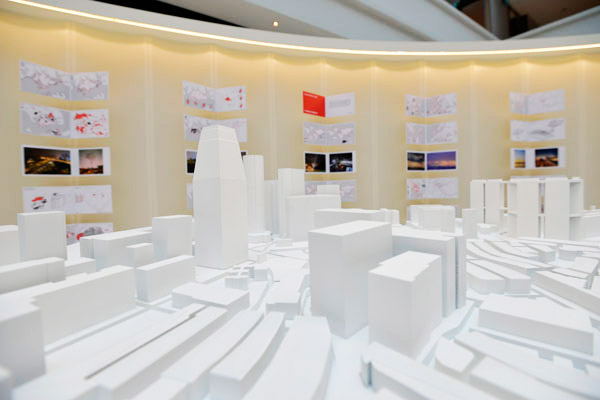1000 Singapores: Eight Points of the Compact City has returned home after a successful debut in Paris. The exhibition draws upon the planning strategies of Singapore and Paris to instigate discourse on dense living as a solution to an increasing world population. Stephanie Peh writes.

January 7th, 2016
Top image: Overview of the 1000 Singapores exhibition. Photo courtesy of DesignSingapore Council
What are the possible methods of sustainable urban development, with the world population in 2050 projected to hit 9.5 billion – a 2.25 billion increase from now? Can large-population cities, such as China or India, be planned like Singapore? Singapore is designed to hold 6.9 million people within a 718 kilometre-square island. Based on that, hypothetically speaking, the entire human race could fit within a land area equivalent to the size of France, if the world were to mimic Singapore’s city blueprint.
This theory is suggested in 1000 Singapores: Eight Points of the Compact City. The exhibition debuted in Paris from June to September in 2015 and has returned home to the National Design Centre (NDC). Commissioned by the DesignSingapore Council, 1000 Singapores invites discourse on the topic of how nations could shift towards building compact cities. The intricacies and synergies shared in the ideals of urban planning between two highly dense cities, Singapore and Paris, were examined and presented. “We found that by drawing our city and comparing our drawings on the same scale as Paris, we were able to see [things with greater clarity]. When we were trying to frame the eight aspects, we were drawing governance, economics, nature – things that were not typically drawn by architects,” says curator Khoo Peng Beng, founder and director of Arc Studio Architecture + Urbanism.

One of the Eight Architectural Models at the 1000 Singapores exhibition. Photo courtesy of DesignSingapore Council
“This exhibition makes us think about the factors that affect a city’s liveability and what new challenges we may face in the future. It raises important questions about how we can live more sustainably, be more energy efficient and how our future generations will live, work and play,” says Chee Hong Tat, Minster of State for Communications and Information, and Health, as he gave an opening speech during the exhibition. He also addressed how Singapore’s achievements in urban planning and design has been propelled by overcoming adversities and challenges, such as land scarcity as well as altering the perceptions of the population – from living on the ground in villages to high-rise housing.
1000 Singapores is curated by Khoo Peng Beng (founder and director of Arc Studio Architecture + Urbanism), Erik L’Heureux (assistant professor at the Department of Architecture, National University of Singapore) and Florian Schätz (Architekt ETH and Director, face2050). The 36-metre circular showcase consists of 300 architectural models, drawings and visuals. Eight large models represent eight points of the compact city: Architecture, Density, Economics, Governance, Infrastructure, Nature, Urban Models and Territories.

300 images and diagrams at the 1000 Singapores exhibition. Photo courtesy of DesignSingapore Council
Varying urban planning models of Singapore and Paris are highlighted. For example, Singapore is a high-rise and high-density city, while Paris is a low-rise and high-density city; Singapore is positioned as a city in a garden, while Paris functions as a city with garden; Singapore has been refined over a span 50 years, while Paris, at over 20-centuries old, is constantly repairing and accommodating.
Both models present varying solutions for dense living, derived over time, and in consideration of the differing needs of its people through design. “In my mind, the greatest invention of Singapore is the act of design as a collective, as a people. This is shown in our city. How could we bring this to the world in Paris?” Khoo explains his curatorial angle.
“During our early years, we have imported ideas from the world to make it [Singapore] work. Today, 50 years later, we have [our own] model, and it needs to grow. Asia needs 100 Singapores to be built in the next 15 years. This is a rapid growth – we took 50 years and we can’t afford to take 50 years [in Asia]. In the next lap of human civilisation, we need to step up as architects or planners. We have to go above ourselves,” he proposes.
1000 Singapores: Eight Points of the Compact City is held at the atrium of the National Design Centre from 15 December 2015 to 28 January 2016. A public forum will take place on 18 January, where the curators will discuss topics in relation to population, urbanism and future cities.
A searchable and comprehensive guide for specifying leading products and their suppliers
Keep up to date with the latest and greatest from our industry BFF's!

In the pursuit of an uplifting synergy between the inner world and the surrounding environment, internationally acclaimed Interior Architect and Designer Lorena Gaxiola transform the vibration of the auspicious number ‘8’ into mesmerising artistry alongside the Feltex design team, brought to you by GH Commercial.

Sub-Zero and Wolf’s prestigious Kitchen Design Contest (KDC) has celebrated the very best in kitchen innovation and aesthetics for three decades now. Recognising premier kitchen design professionals from around the globe, the KDC facilitates innovation, style and functionality that pushes boundaries.

Create a configuration to suit your needs with this curved collection.

Marylou Cafaro’s first trendjournal sparked a powerful, decades-long movement in joinery designs and finishes which eventually saw Australian design develop its independence and characteristic style. Now, polytec offers all-new insights into the future of Australian design.
The internet never sleeps! Here's the stuff you might have missed

Adaptive reuse is all the rage across the design industry, and rightly so. Here, we present a selection of articles on this most effective approach to sustainability.

Dallas Rogers, Head of Urban Discipline at the School of Architecture, Design and Planning, University of Sydney, comments on the history of map-making in our cities.